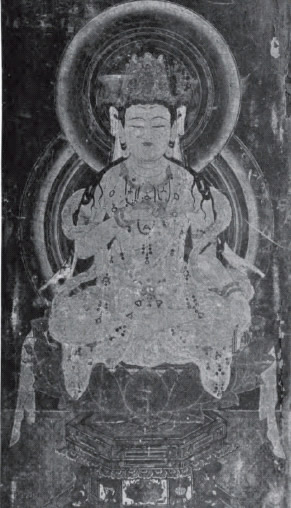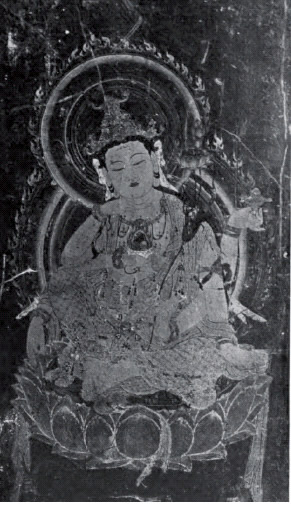Faces of Kwannon
Now let us see how the spirit of mercy is personified. One of the most popular deities of mercy included in the cosmic cycles is Kwannon. His Sanskrit name, Avalokiteshvara probably meaning On-looking Sovereign, is masculine in gender, and though he appears sometimes as a formidable conqueror, he is oftener and perhaps more properly shown as a deity of love and com passion, quite feminine in the gentleness of his expression. Hence he is preeminently known and worshipped as a merciful benefactor of mankind. In his hand he carries a lotus flower; his bright hair hangs beautifully about his shoulders, which are always draped, and the rest of his body is partly covered with veils and garlands.
 KWANNON Artist unknown Japanese, Kamakura Period, Late Thirteenth Century In the Museum of Fine Arts Boston
KWANNON Artist unknown Japanese, Kamakura Period, Late Thirteenth Century In the Museum of Fine Arts Boston
This deity is believed to manifest him- self in six, twenty-one, or thirty-three dif- ferent forms, in order to induce enlightenment and felicity in beings of various kinds. Three of the set of six manifestations are illustrated here. A. Byaku-e Kwannon (Sanskrit, Pod- dara-vasinil), the White-robed, is a feminine manifestation. Her whole body is pale gold in tone, and is partly covered with thin veils "like morning mists." In her right hand she holds a casket containing the sacred scripture, and in her left, a cord. She is supposed to avert disaster in response to prayer.
It is important to notice that all the acts of worship in Buddhism are illustrated by what is beautiful, whether in color or in form, in rhythm, in odor, in style or in expression. The Play is the beauty of manner and posture; the Garland , of form and composition; the Song, of word and metre; the Dance, of movement and rhythm; the Flower, of color and fragrance; the Lamp, of light and warmth. Regarding the Incense and the Perfume, it should be remembered that perfume plays a great part in all Buddhist ceremonies, and that Buddhist artists used to burn incense in their studios. In short, these symbolic figures typify the fundament al qualities of all branches of the fine arts and are summed up in the emblematic lotus flower. Their title, "Indestructible," may therefore be paraphrased by the term "Prototype," because they represent the ideal dements of art in the mind of the Great Illuminator. Indeed the artistic presentation of deities and the organization of elaborate rituals, both characteristic features of Shingon Buddhism, are embodied in this way in two squares of the Diamond Cycle, and it is a matter of pride among the Shingon Buddhists that they serve truth and beauty at the same time and by the same act. In a word, the worship of Divinity should not and cannot be dissociated from the cult of beauty, and art, therefore, must be an integral part of religion.
Sho-Kwannon (Sanskrit, Arya-Avalo- kilesvara), the Holy Compassionate Lord. This is the most usual appearance of the deity. In his left hand he holds a lotus flower, symbolic of the essence of enlighten- ment inherent in every one's soul, which he induces to bloom more fully by the gesture of his right hand. On his head he wears a crown in which is set a figure of the Buddha Amita, Lord of the Western Paradise, whom Kwannon serves.
 Nyoirin Kwannon, the Lord who, having mas- tered the secret of the Cinidnuini Jewel, turns the mysterious Wheel of Truth (Dharma-chakra). *He has six arms. The first right hand supports the chin, — an attitude of meditation in compassion for beings immersed in the purgatories ; the second holds the Jewel which grants every wish, so that response may be made to the needs of hungry ghosts; the third holds a rosary which redeems bestial existence; the first left hand rests on a symbolic representation of a mountain, implying the salva- tion of ferocious spirits (Sanskrit, Asura) by the virtue of firmness; the second holds a lotus which purifies mankind of all depravities; and the third grasps the wheel of truth which governs the cosmos and en- lightens all beings. The crown is set with a figure of Buddha Amita, and the lotus pedestal rests on a rock in the sea of wisdom.
Nyoirin Kwannon, the Lord who, having mas- tered the secret of the Cinidnuini Jewel, turns the mysterious Wheel of Truth (Dharma-chakra). *He has six arms. The first right hand supports the chin, — an attitude of meditation in compassion for beings immersed in the purgatories ; the second holds the Jewel which grants every wish, so that response may be made to the needs of hungry ghosts; the third holds a rosary which redeems bestial existence; the first left hand rests on a symbolic representation of a mountain, implying the salva- tion of ferocious spirits (Sanskrit, Asura) by the virtue of firmness; the second holds a lotus which purifies mankind of all depravities; and the third grasps the wheel of truth which governs the cosmos and en- lightens all beings. The crown is set with a figure of Buddha Amita, and the lotus pedestal rests on a rock in the sea of wisdom.
